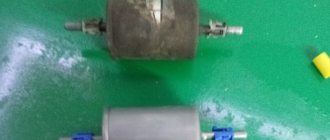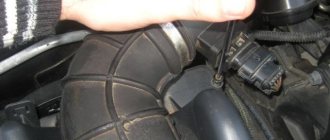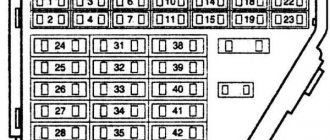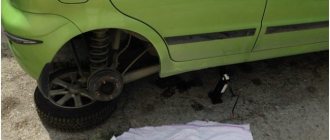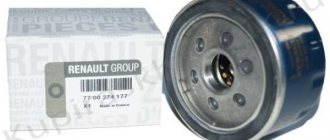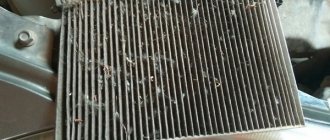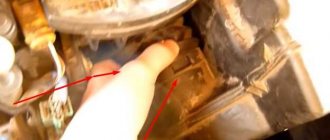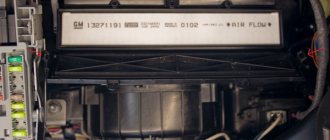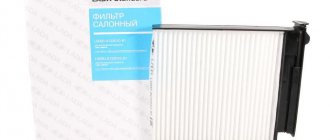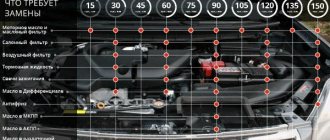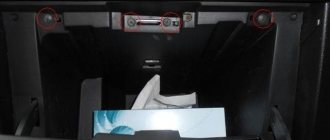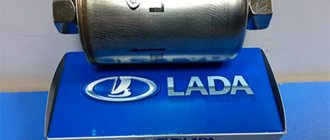Despite the constant improvement of quality standards, diesel fuel or gasoline almost always contains mechanical impurities and contaminants (corrosive particles, dirt), the presence of which negatively affects the operation of the car engine. To eliminate them, as well as to protect the system from water (condensate) entering the combustion chamber, fuel filters are used. The absence of the latter provokes premature wear of the fuel pump, as well as the injectors of the injection system.
Purpose, principle of operation
A fuel filter (or fine filter) is designed to remove dust, solid particles, sediment from the bottom of the gas tank, water, paraffins and, in general, everything unnecessary that hangs around in the fuel mixture and can damage the engine from the gasoline (diesel fuel, gas) entering the engine. The better the filter, the better the fuel will be cleaned, which means the engine will run longer without problems.
Schematic diagram of a direct-flow injection filter
The location of the filter is between the gas tank and the engine in front of the pump (or in front of the carburetor in older cars). Gasoline (diesel fuel) passes through the filter material under pressure, purifying it of impurities before further use. Filters for diesel engines also have a membrane for separating water, as well as a heating system that ensures the fluidity of diesel fuel at sub-zero temperatures.
It is impossible to clean the smallest pores of the filter from contaminants either at home or in an industrial environment, therefore, when the resource is exhausted (or earlier, if it is critically contaminated), the filter is simply replaced with a new one, and the old one is handed over for recycling.
Features of diesel fuel filters
The main task of diesel fuel cleaning is to prevent condensation from entering the engine.
In most cases, water is separated from the fuel by a separator filter.
The diesel fuel filter must heat the fuel and protect the engine from condensation
In addition, the properties of diesel fuel change with decreasing temperature.
Therefore, the filter must be adapted to the cold. This problem can be solved by adding a heating system to the filter (for example, a curtain can be made of paper capable of conducting current).
This way, the optimal temperature of the mixture of cold fuel from the tank and heated fuel from the filter is maintained.
Some models of fuel filters for diesel engines have a condensate separation system and sensors that indicate the water content of the fuel.
Is a filter really necessary? What does it affect?
First of all, the purity of gasoline is important for the injectors of an injection engine: their thinnest holes become clogged with deposits of paraffins, sulfur, dust, dirt and other “goodies.” This is followed by deterioration in engine performance (after all, the required amount of fuel does not enter the cylinder and is not dissipated properly), loss of power, “triple”, when an injector in one of the cylinders fails, and after that - expensive repairs. For systems with a fuel injection pump (high pressure fuel pump), cleaning is carried out before fuel enters the pump: the fine fitting of the parts does not withstand foreign impurities. Buying a new pump also costs a considerable amount.
Clogged injectors
If we compare the quality of European and Ukrainian fuel, the latter will be far from winning: the purity of our gasoline is such that the service life of good imported filters is exhausted almost 2 times faster than the manufacturer expected. Impurities in gasoline appear both at the manufacturing stage (manganese to increase the octane number, sulfur and paraffins due to insufficient purification) and at the transportation stage (dust, dirt). The level of the plant itself will also be an important factor: gasoline purification is a delicate matter and requires modern, expensive equipment. You can evaluate the quality of the fuel yourself by disassembling the old filter after replacing it, as many car owners like to do. All the dirt that has collected in the filter could end up on the pistons, injectors and engine walls.
But, be that as it may, fuel filters are installed on absolutely all cars all over the world: no matter how clean the gasoline is, additional protection will not hurt. We have a good filter - not a precaution, but a vital necessity.
Replacement on different types of engines
Regardless of what make and year of manufacture your car is, you will need a standard set of tools to dismantle and install the filter element:
- open-end wrenches;
- screwdriver with a thin flat blade;
- pliers;
- WD-40;
- clean fuel container;
- rags.
How to remove a filter from a carburetor engine
The procedure is made as easy as possible by the fact that the filter is installed in the engine compartment of the car. That is, it is enough to wait until the engine cools down, and then begin dismantling.
The order of work after releasing the pressure in the fuel system looks like this:
- Open the hood.
- The filter itself is located near the brake fluid reservoir, near the carburetor.
- Unscrew the clamps securing the two hoses.
- Remove the fuel hoses from the sides. Fuel may leak, so it is better to place a container or a rag under the holes in advance.
Disconnecting the fuel lines
Accordingly, installation of the new element is carried out in the reverse order.
How to remove the fuel filter on injection car models
The work will be somewhat more difficult than in the previous case. On injectors, the part is located under the bottom, so you will first need to either drive the car into an inspection hole or jack it up high.
In this case, the precautions will be the same as when working with carburetor engines: before dismantling, you will need to relieve the pressure in the system. Further work is carried out according to the following scheme:
- Find the fuel pump in the center of the rear beam.
- It is usually difficult to unscrew the nuts the first time, so it is recommended to lubricate the joints with WD-40 first.
- After this, unscrew the two connecting nuts and remove the fuel pipes (place containers in advance to drain the remaining fuel).
- Remove the filter along with the rubber seals from the bracket.
- After which you can install a new one in the free space.
The main thing is to create comfortable working conditions
Types of fuel filters
The first step in the filter system is coarse cleaning: a regular dense mesh installed inside the gas tank, designed to filter out particularly large particles.
Next is the fine filter, which, in fact, is what we are talking about: it retains fine particles, which, nevertheless, can clog the injectors of an injection or diesel engine.
Different filters are made for different types of fuel: there are varieties for gasoline, diesel fuel, and gas.
The following fuel filters are distinguished by location:
- Submersible filters located in the fuel tank. This is a one-piece structure into which a fuel pump, a coarse filter and a fuel level sensor are connected.
Submersible filters
- Main filters that are included in the fuel line in the area from the gas tank to the pump. If a main filter is provided in the design of the car, then preliminary fuel purification is carried out directly in the gas tank (a fine-mesh mesh that retains large particles before they enter the fine filter)
Depending on the type of engine, there are:
- Filters for carburetor systems that are not demanding on the quality of gasoline. Such filters have the simplest design, allowing them to retain 60 percent or more of particles up to 15 microns in size.
- Filters for injection engines sensitive to gasoline purity. They have a more complex design, a durable body and can trap contaminants up to 10 microns in size.
- Filters for diesel engines requiring high-quality fuel, capable of retaining not only the smallest particles, but also water and paraffins. The best modern filters are capable of removing up to 95% of contaminants up to 5 microns in size!
- Filters for cars with LPG, since liquefied gas is also not particularly clean.
Purchasing a new item
When choosing this item, be sure to pay attention to the following parameters:
- filtration level. If it is not enough, and large particles get into the system along with the fuel, this will very quickly lead to engine failure;
- the area of the filter element, as well as the presence of a rubber seal that covers the entrance to the filter itself. If there is none, replacing this part will be very troublesome.
Depending on the fuel system, fine filters are divided into:
- carburetor, permissible degree of cleaning is 15-20 microns (the smallest particles will pass into this system, but will not harm the fuel supply system to the engine);
- injector, finer degree of purification, 5-10 microns (in such systems, the requirements for the maximum permissible size of contamination are higher, i.e. the injector can become clogged with larger particles, so the holes in the filter are smaller);
- diesel engines are capable of not only retaining very small solid particles (less than 5 microns), but also removing moisture, which is very important for a diesel engine.
When purchasing, it is important to tell the seller the make and year of your car in order to choose the right filter. For the most part, if there is no specific product for your case, then you can choose something interchangeable. But there are times when this is not possible, so check your vehicle's owner's manual for this information.
Subtlety of elimination
Screening fineness is an indicator of the number (as a percentage) of particles of a certain size that the filter retains.
The level distinguishes between average, nominal and absolute screening fineness with specification of particle size.
- Medium means that the filter captures 50% of particles of a certain size;
- Nominal – screening out 95% of particles;
- Absolute – complete screening, the filter retains 100% of particles.
In the characteristics of the filter, this indicator is indicated as follows: “Nominal screening fineness 15 microns,” and this means that the filter retains up to 95% of particles up to 15 microns in size.
Modern filters are developed in accordance with strict environmental standards, and their nominal screening fineness can be 6 microns, 4 microns or less. Such filtration is important primarily for diesel engines, which are more sensitive to fuel purity, and at the same time more hazardous to the environment than gasoline engines. The better the fuel purification, the less harmful emissions.
Filter design
The simplest filters are made for old carburetor engines: a filter element is installed inside the housing (often transparent to visually control the degree of filling) - special paper folded into a star-shaped curtain. Through the inlet pipe, gasoline enters the filter housing, passes through the paper and enters the outlet pipe. Such a system is quite sufficient for cars that are not demanding on the quality of gasoline.
Injection engines are much more sensitive to the quality of cleaning, and the fuel pressure in the system is an order of magnitude higher. They consist of a durable body (metal or high-quality plastic) and good filter material (paper is folded in a star shape or wound in a spiral, the second option is better in terms of filtration quality).
Diagram of a direct-flow injection filter
Diesel engines are the most demanding on fuel quality, which means that filters for them have the most complex design: not only separating solid particles, but also removing water, paraffins, sulfur and other impurities.
Diagram of a diesel filter with water separation
To achieve high filtration rates, a special material is used, the cells of which are not evenly spaced, but with a decrease in size from the surface to depth: larger particles are retained in the upper layers, smaller ones in the deeper ones. This internal structure greatly extends the life of the filter, because it clogs less and can pass fuel in the required volume for longer.
What is the danger of dirt?
In carburetor-type engines, the ejector principle comes into force, when air at high speed pulls fuel with it at low speed. That is why, when developing jets, strict adherence to patterns and clearances is important. A discrepancy of a hundredth of a millimeter can have negative consequences on the operation of the system as a whole. In particular, the volume of air entering the system changes, power drops, throttle response decreases, and so on.
We must not forget about another potential problem - clogging of the injector (nozzle). It is no secret that in engines running on diesel fuel and gasoline, the fuel mixture and air are mixed directly in the engine. First, pressure is created, thanks to which the fuel mixture flows to the power unit.
For example, in gasoline engines the supply pressure is 10-20, and in diesel engines 100-200 atmospheres. In this case, the volume of fuel supply is regulated by the controller. As soon as the control body sends the appropriate signal, the injector valve opens, followed by spraying of the combustible mixture into the combustion chamber.
Diesel engines (usually older versions) used a slightly different principle for supplying the fuel mixture. In particular, the main operating “person” was a plunger pump that creates the necessary pressure. As for the volume of incoming fuel, the plunger mechanism takes on this work.
But that's not all. Contaminated fuel can cause problems for the cylinder head by clogging the spaces between the seat and the valve. As a result, a cavity forms and compression decreases. At the same time, almost all characteristics of the power unit deteriorate - power, resource, “gluttony” and so on.
Features of execution
According to the method of execution, they are distinguished between direct-flow, screw-on and cartridge filters.
Direct-flow filters are used in carburetor and injection gasoline systems. There are pipes installed at the inlet and outlet through which the filter is connected to the fuel system. Gasoline enters the housing, passes from the outer walls to the center through the filter element and is sent for further use. The pipes can be located either on one side of the filter (in the cover) or on opposite sides.
Screw-on filters have a threaded connection with which they are connected to the fuel line. Fuel enters through a larger diameter with holes around the circumference, and exits through a smaller central one. Such filters are designed for high pressure and are made in a durable metal case or plastic case with a metal lid.
The filter cartridge consists of a metal casing (glass) and a replaceable core with a filter part. The filter element can be purchased separately, and thus save money on regular fuel filter replacements.
Filters for injection engines have a fuel pressure regulation system: an additional outlet pipe into the gas tank, through which excess gasoline is removed from the system. In diesel engines, filters also remove air bubbles and are designed with a bleeder valve to release excess air.
In diesel filters, the container (often transparent) for collecting water has a drain valve through which accumulated water can be drained from the filter.
Thus, the modern fuel filter has evolved from a simple device to a self-regulating system necessary for long and high-quality engine operation.
Why does fuel get dirty?
The operation of the internal combustion engine depends on the quality of the incoming fuel. The poorer the quality of the fuel, the more various impurities it contains. To clean the fuel from impurities, a fine fuel filter is used. The article highlights why you need to change it and describes in detail how the replacement is performed.
Content
[ To uncover]
[Hide]
Why do you need to change the fine filter?
Any car that uses various working fluids is equipped with special elements that serve to cleanse the fluids from harmful impurities. The fuel system uses a coarse and fine filter to clean the fuel. During the operation of the car, it becomes clogged and does not perform its functions efficiently. Therefore, it has to be changed periodically.
BIG fuel filter
Gasoline contains abrasive particles that negatively affect the operation of the internal combustion engine. There are special meshes on the gas tank, carburetor and fuel pump for cleaning fuel, but they are not enough for high-quality purification of gasoline. They can only trap large particles.
Fine filters are designed to capture small particles. They can trap elements as small as 15 microns.
If you do not change the filter element in time, this can lead to the following problems when operating the car:
- The engine runs jerkily, first at high speeds, and then when switching to low speeds.
- The car loses power. A contaminated element does not perform its functions, as a result, the fuel injection nozzles become clogged and the fuel system becomes clogged. Thus, an insufficient amount of gasoline enters the engine, which leads to a decrease in its power.
- Premature wear of lambda probes, spark plugs and accelerators. If cleaning is poor, the fuel does not burn out completely; some of it settles on the cylinder walls, spark plugs and pistons. As a result, the fuel mixture is saturated with heavy metals and foreign particles, and then enters the exhaust gas system through accelerators and lambda probes, which significantly reduces the service life of parts.
- Fuel consumption increases. A clogged fuel filter does not directly affect fuel consumption, but it does cause a decrease in vehicle power. As a result, to accelerate the car to the desired speed, you have to put more pressure on the gas, which requires more fuel consumption.
- The car won't start. If you neglect to change the filter element, as required by the manufacturer, the engine may not start.
Filters differ in design and are divided into non-separable and collapsible products. Non-separable ones refer to disposable parts.
Non-separable fuel filter
The collapsible one consists of a ceramic element and a mesh that can be cleaned, washed and used several times. The cost of a dismountable filter is slightly higher than a disposable one.
Where is?
If the procedure for replacing the fuel filter is the same on almost all car models, then the location where it is located differs. Most often it is located in the upper part of the car's engine compartment, and it is also often placed in the tank next to the gas pump.
Depending on where the filter element is located, to carry out replacement the machine is either driven onto a lifting device or placed in a convenient position to ensure access to the part.
The process of replacing the fine filter
The conclusion that the filter needs to be changed can be made from a visual inspection. But there are signs by which you can determine that it is clogged: frequent jerking at high and low speeds.
If, after inspecting the filter element, it turns out that it is clogged, then there are two options for solving this problem:
- try to clean the element from contamination;
- replace with a new product.
You should not wait for the contaminated element to manifest itself.
Manufacturers recommend changing the filter element after 10,000 -15,000 kilometers. If the car is used in difficult conditions, low-quality gasoline is poured in, the replacement should be performed more often - after 7-8 thousand km.
The first obstacle to suspended particles in the fuel is the filter element in the fuel tank of the car. As a rule, it is a frame sealed in a mesh, which is a barrier to solid particles. This type of cleaning cannot prevent small particles, water, paraffins and resins from entering the fuel equipment.
But thanks to it, most of the large elements - corrosion products and debris - are eliminated. They are present in any fuel tank. This prevents clogging of low-pressure lines, and also significantly increases the service life of the coarse filter.
In most cases, replacing this element is not regulated by the manufacturer, but it is recommended. Its service life directly depends on the newness of the car, its technical condition and fuel quality. The mesh element in the car tank is the cheapest link in the entire chain of fuel supply to the engine, but no less important, so you should not neglect checking it and, if necessary, replacing it.
The second stage is carried out by “coarse” fuel filters (sediment filters). Their name is due to the presence of a settling glass. In the lower part it is equipped with a damper, thanks to which it is possible to remove water.
DETAILS: Replacing the cabin filter Nissan X-Trail Photo instructions on how to change the cabin filter X-Trail T31
And in its upper part there is a mesh or plate filter element, which allows you to get rid of particles up to 0.05 mm in size remaining after the first stage. Next, the fuel enters the low pressure fuel pump (LPFP).
This type of filter has a drain plug to clean the glass from condensation and sediment. Most sediment filters have a collapsible design. This design of the diesel engine fuel filter makes it possible to wash and, if necessary, replace the filter element and thereby restore cleaning efficiency.
A special type of filter at this stage are heated separators for diesel fuel. Their price is significantly higher than that of conventional settling filters, but the quality of fuel purification is more effective, and heating solves the problem of paraffins. They are capable of removing up to 95% of water and impurities from diesel fuel.
The cleaning process begins with the fuel heating stage, which prevents the crystallization of paraffins and water. Then, under the influence of centrifugal forces that arise when the emulsion swirls and passes through special channels, water and impurities are separated and deposited in the settling glass.
To separate smaller particles, the principle of changing the direction of flow is used, which is implemented using separator blades. The final stage is a corrugated cartridge that removes the smallest solid particles.
Often there are “coarse” filters connected to a booster pump or a “fine” filter.
In most cases, contamination of “coarse” filters will not be noticeable during vehicle operation, because The performance of the injection pump is always higher than necessary for stable engine operation. Therefore, in order to prevent costly repairs, it is necessary to promptly remove accumulated water and debris from the sump and not ignore the need to replace the filter element.
It is recommended to check the presence of sludge and condensate daily. During the cold season, it is better to do such a check after each trip. The service life of the filter element does not exceed 15-30 thousand km.
The final barrier for fuel before it enters the diesel engine is a fine filter. It allows you to get rid of the solid particles remaining in the previous stages that are not visible to the eye, as well as the formed resins. Another of its functions is to protect the engine from air that gets into the fuel during the early stages of cleaning.
Through the jet valve, air with excess fuel is discharged back into the tank. The temperature difference between the exhaust mixture and the fuel in the tank contributes to the formation of condensation and an increase in water content. The “fine” cleaning function at this stage is performed by a replaceable element consisting of special porous paper.
When pouring fuel into the tank, car enthusiasts do not even think about the possible risk of contamination of the combustible mixture. It is believed that oil refineries have completed the full purification cycle and delivered already purified fuel to gas stations. In principle, this is how it is.
But we must not forget that fuel is delivered by rail in tanks or by sea in tankers, and is distilled using special tubes and hoses. As a result, the fuel accumulates harmful substances, most of which clog the internal systems of the car.
Hazardous elements do not disappear anywhere - they accumulate in transportation containers (tanks, tanks). In the process of filling a new batch of fuel, the active mixture rises from the bottom and mixes with the once pure gasoline or diesel fuel. Next, the fuel goes to the car tanks and to the engine.
Operating the fuel filter
Actually, operation does not require special attention from the car owner: all requirements boil down to purchasing a high-quality filter, correct installation and timely replacement. For diesel cars, filters with a water sump can be installed; then, from time to time, accumulated condensate must be drained from them through a special valve.
Since the filter model depends on the engine model (cars of the same brand can have different engines, which means they need different filters) and its volume (the larger the engine volume, the larger the filter volume), the replacement schedule is indicated in the service book. When undergoing maintenance, the fuel filter is changed as one of the consumables.
On average, a filter for gasoline injection engines has a service life of up to 40 thousand km. For diesel filters, the resource depends on the method of laying the filter element: a radially folded “star” will last approximately 24 thousand km, and a spiral winding has a much longer resource - up to 40 thousand km.
The filter life is affected by several factors:
- The quality of gasoline, the purer the gasoline, the longer the filter will work fully.
- The quality of the filter itself. The filter element (special paper) is produced by just a few large specialized factories, which receive orders from filter manufacturers. The totality of the design of all parts (body, cover, filter core, pipes, etc.) also determines the service life of the filter itself, because in addition to clogging, it can leak, crack and present other unpleasant surprises.
- Changing summer diesel fuel to winter and vice versa. Paraffins that accumulate in the filter clog it tightly, rendering it unusable, so switching to winter fuel is one of the conditions for the uninterrupted operation of the fuel system.
Paraffins in the fuel filter
- Emergency situations that arise during vehicle operation. For example, water condensate may freeze in the filter and thus damage the porous filler.
- Poor quality gasoline. Impurities that are sometimes added to fuel corrode the filter element, rendering it completely unusable in a very short time. That is why most drivers prefer to refuel at gas stations of large companies that monitor the quality of fuel.
On diesel cars, an additional heater for the filter can be installed: in winter, the fuel thickens during parking until a dense gel is formed, and to facilitate engine starting, pre-heaters are installed on the filter, heating diesel fuel to a temperature above the freezing point of paraffins.
Diesel filter with heater
Signs of a clogged or failing fuel filter
A filter malfunction is manifested, at best, by a decrease in fuel supply:
- Gasoline consumption increases;
- “Trippling” - one of the engine cylinders does not work;
- The engine power decreases, which becomes noticeable during acceleration or driving uphill. This is a rather dangerous situation on the highway when, instead of overtaking the car in front, you end up with “synchronized skating” due to the inability to pick up speed;
- The car suddenly stalls while driving or at a traffic light;
- The engine does not start at all.
If the cause is a clogged fuel filter, these faults can be easily eliminated by simple maintenance. There are also worse options: if the filter turns out to be of poor quality or the internal structure is damaged, unrefined gasoline will flow into the fuel injection pump and engine, leading to more serious problems. This will be heard from the operation of the pump (noise during movement) and the engine (the same “triple movement”, vibration and loss of power).
What is the replacement period?
In the average version, manufacturers recommend replacing filters after 30,000 km. Many car owners, through experimental observations, also came to this mileage figure.
Symptoms that the filter needs to be changed may include:
- Triple
- And turning off the engine
Of course, not everything can be exactly like that. When you refuel at gas stations known for their high quality fuel, adhere to a leisurely driving style, and rarely drive on rural roads, then you can greatly increase the frequency of filter changes. But in practice this rarely happens.
Selecting a fuel filter
The filter installed on the car is only the one that strictly corresponds to the engine parameters, neither better nor worse. Injection filters are not suitable for carburetor systems, and if you really want to get high-quality filtration, you need to choose a filter of higher quality, but of the appropriate type.
When choosing, you need to focus on the engine brand and technical parameters: external and internal diameters, diameters of the inlet and outlet pipes, overall dimensions of the housing. When purchasing, you should also pay attention to the complete set of the filter: many manufacturers add spare o-rings, which will come in handy when replacing the filter.
On average, the larger the engine size, the larger the filter volume and its throughput will be.
How to make a choice
When choosing a fuel filter, you should pay attention to:
- Device performance. The coincidence of the diameters of the filter inlet and outlet fittings with the diameter of the fuel pipe tube is a sure sign of suitability, but it never hurts to clarify the parameters;
- Filter service life declared by the manufacturer. Avoid buying fuel filters whose manufacturers guarantee uninterrupted operation of the device throughout the entire service life of the vehicle;
- Manufacturer's reputation. Little-known manufacturers can put a plastic mesh wrapped in blotting paper on the filter, sell the batch at a dumping price and disappear from the market forever.
Inspection of the used filter
The condition of the removed filter can tell the car owner a lot:
- There is a lot of black dust in the filter pleat - the presence of manganese additives in gasoline;
- The filter is all clogged with dirt - the fuel contains a large percentage of resins and asphaltenes;
- Black mucus on the filter element – there is fungus or bacteria in the fuel;
- Wave-like curvature of the corrugated element - there is a large amount of water in the fuel.
But the condition of the outside is not as important as the type of filter inside the central channel: if there are no deposits on the inside and the paper is clean from the inside, then the filter coped with its task.
